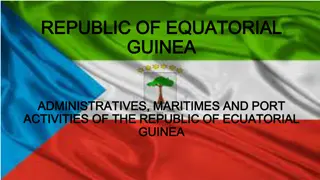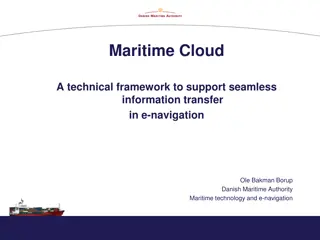History of Transportation Innovations: Impact on Maritime Travel
Explore the evolution of maritime transportation through the ages, from oared galleys and sailing ships to the revolutionary steam-powered vessels. Learn about the advantages and disadvantages of different ship types, including their impact on trade, exploration, and warfare. Discover how innovations such as the lateen sail and full-rigged ship transformed maritime history.
Download Presentation

Please find below an Image/Link to download the presentation.
The content on the website is provided AS IS for your information and personal use only. It may not be sold, licensed, or shared on other websites without obtaining consent from the author. Download presentation by click this link. If you encounter any issues during the download, it is possible that the publisher has removed the file from their server.
E N D
Presentation Transcript
Getting from here to there and back The impact of a few transportation innovations on history Class 3 William A. Reader E-mail: williamreader40@gmail.com 1
What We Will Cover Today Sailing Ships Galleys & Early Sailing Ships Carracks, Caravels & Full Rigged Ship Impact of the Sailing Ship Piracy The impact of the steam-powered vessel Steamboat Steamship Refrigerated steam-powered vessel Container Ship
Impact of the Ocean-going Sailing Ship
Early Ships Oared Galleys Ships could be oared galleys or sailing ships Both types had their advantages and disadvantages Galleys Could make way on windless days Required a large crew to man the oars Could not venture for long out of sight of land Crew had to be fed so landfall had to be frequent Could not carry a large number of cannon
Early Ships Sailing Ships Sailing ships revered the advantages and disadvantages of oared galleys Sailing ships Were high-sided and more seaworthy, especially on the oceans Were difficult to maneuver and helpless when becalmed Could not accelerate on command Could accommodate large cargoes Could be handled by small crews that were easily sustained over a long period of time Could accommodate a large number of cannon
Medieval European Sailing Ships Medieval northern European ships were known as cogs with a single, massive, square sail. Cogs used clinker planking (overlapping wooden planks) Medieval Mediterranean and Indian Ocean sailing ships used the Arab lateen sail or triangular sail
The Full-Rigged Ship In the mid-15th century, the lateen-rigged Mediterranean ship was married to the square-rigged north European ship (and the stern rudder added) to produce the full-rigged ship There were two variations of the full-rigged ship The Carrack a 3-masted ship with a foremast and main mast rectangular sail and a mizzenmast lateen sail The Caravel a 3-masted ship with 3 lateen sails
Carricks & Caravels Carracks were largely-ocean going vessels They were large 600+ ton ships Columbus flag ship, the Santa Maria, was a carrack Caravels were smaller in size They were smaller than the carrack from 60 to 120 tons 2 of Columbus ships were caravels
Other 15th Century Sailing Innovations In the 14th century, the compass arrived and the astrolabe, cross-staff, and quadrant were developed Medieval portalan charts evolved into maritime maps showing coastlines, port locations, parallels, and meridians By 1500, a spritsail was attached to the mast jutting forward from the bow It provided leverage against the rudder, enabling vessels to sail as close to 800 to wind and also to pull away from a leeward shore
Subsequent Evolution of the Full Rigged Ship By the 18th century, the full rigged ship had further evolved Copper sheathing of the underwater hull Overlapping joints to strengthen the frame of the ship Sprit sail replaced by bowsprits with new booms for jib sails Mizzenmast with lateen sails replaced by a large gaffsail with beam
Impact of cannon - 1 Prior to the invention of cannon and gunpowder, oar- driven galleys would ram enemy vessels, allowing marines to swarm onto the enemy vessel With the invention of cannons, ship battles became artillery duels at very short range With the gun port a hinged door built into the side of a ship cannons could now fire from lower decks and carry more and heavier guns just above the waterline When the ship was sailing, the ports closed and caulked kept out the sea During a battle, the gunners opened the gun ports and fired away
Impact of Cannons - 2 Led to the cannon-armed sailing ship replacing the oared galley Led to the seaborne expansion of Europe and the Age of Exploration Allowed Europeans to establish trading posts and forts on the coasts of Africa and the Indian Ocean In 1509, the Portuguese defeated the Muslim fleet off the Indian port of Diu to win naval supremacy in the Indian Ocean European sailing ships could carry many more cannon than Ottoman galleys, Arab dhows, or Chinese junks
Why America Was Not Discovered Until 1492 - 1 Before 1492, European intellectuals, rulers, & sailors knew the earth was round They also had a good idea of the circumference of the earth 24,000 miles as opposed to our 25,000 This meant Asia lay about 10,000 to 12,000 miles west of Europe 15th Century European ships were too small to carry the food and water needed to sustain crews on such a voyage
Why America Was Not Discovered Until 1492 - 2 The fall of Constantinople in 1453 caused spice- trade costs to go through the roof Retail prices of spices in Europe skyrocketed as a result of Turkish price gouging The alternative overland travel route via the Silk Road became too dangerous This led to the European desire to seek new routes to the East Led to the Portuguese sailing around the tip of Africa into the Indian Ocean Led to the Spanish (and later the English and French) sending explorers to the West
Why America Was Not Discovered Until 1492 - 3 Columbus radically underestimated the circumference of the earth His estimate was 18,000 miles He also calculated that Japan was only 3,500 miles west of Europe What saved Columbus and his crew was the fact that the Americas were about 3,000 miles west of Spain
Piracy and Smuggling The combination of the ocean-going sailing ship, cannon, and the European wars over colonies and fishing rights led to piracy and smuggling During wartime, nations gave their nationals the right to prey upon enemy merchant shipping for profit The U.S. Constitution gave Congress the right to grant Letters of Marque and Reprisal and make Rules concerning Capture on Land and Water Smuggling (to avoid payment of import taxes) was common The attempts to suppress smuggling in the American colonies played a major role in precipitating the American Revolution
End of Piracy For merchants, piracy raised the risks and costs of all ocean-going voyages This led merchants and companies which had formerly engaged in piracy to pressure governments to repress it A combination of legislation, international treaties, permanent navies, and ironclad ships ended piracy
European Voyages of Discovery Brought Europeans into contact with cultures that were very different Challenged core European concepts Neither the Bible nor the Greek philosophers mentioned the Americas (or Australia or Antarctica) Led to the Columbian Exchange Eurasian crops and animals began to be raised in the Americas American crops began to be cultivated in Europe, Asia, and Africa
European Discovery of Hunter-Gatherers The discovery by Europeans of hunter-gatherer bands in the Americas and the Pacific Islands had some very interesting intellectual consequences Led to the creation of the concept of the noble savage Led to the concept that private property was the root of all evil e.g. Jean Jacques Rousseau Led to the concept of primitive communism e.g. Karl Marx & Friedrich Engels Led to the concept that society could be based on free association rather than submission to traditional authority 27
The Columbian Exchange Europeans and Africans, along with their animals and insects, introduced diseases into the Americas with devastating effects Malaria, yellow fever, mumps, measles, chicken pox, smallpox, and influenza killed a large proportion of the American Indian population Led Europe to shift its external trade from the Levant to the New World Led to the economic decline of the Islamic world
The Columbian Exchange - 2 Led to a change in European, Asian, and African dietary habits Imagine Thai, Indian, or Chinese cuisine without chili peppers or peanuts Imagine Western Europe and Russia cuisine without the potato Imagine Italian cuisine without the tomato Imagine African cuisine without manioc or corn
Other Effects of Ocean-going Sailing Ships Allowed the Portuguese to colonize islands off the coast of Africa where sugar could be grown Since sugar was a labor-intensive crop, the Portuguese began importing African slaves and establishing sugar plantations to grow and process the sugar Formed the template for slavery in the Americas Allowed European ships to exploit the fishing grounds of the North Atlantic and the Newfoundland banks Fishing and later whaling played a major role in the development of the New England economy Fishing in turn led to shipbuilding, timber exporting, and barrel-making
Other Effects of Ocean-going Sailing Ships - 2 Made possible the triangular trade that linked New England, the Caribbean, England, and Africa Via the Manila Galleon, it brought East Asia into the European trading system Exchanged Mexican silver for Chinese luxury goods
Wooden Casks In the 17th-18th centuries, wooden casks were the shipping containers of the day Even fragile items (packed in straw or sawdust) were shipped in them Shippers of wine and hard liquor noticed that the process of shipping improved the flavor, taste, and smell of the product Led to the process of storing wine and liquor in casks
Clipper Ships The clipper ships led to a vast increase in the tea trade with China The growing demand for tea in Britain led to the growing importation of Chinese porcelain as ballast The demand for tea cups and saucers that could hold hot tea led to the rise of the British porcelain industry Wedgwood China























